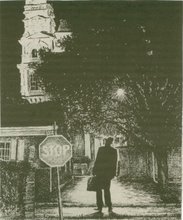
“The more things change, the more they remain the same.”
As I made my way along Middle Street in Gloucester, from the Sawyer Free Library down to the Joan of Arc statue, this aphorism coined by the 19th century French novelist Alphonse Karr popped into my head. I can’t say exactly how it happened, except that I was meditating on the fact that I’d first taken this walk in 1949, when I was in seventh grade at the Central Grammar School.
Though it was fifty-eight years ago, I can remember those walks from school to my house at 3 Perkins Road as if they occurred yesterday. I can still picture the skinny kid in the maroon and silver Mighty-Mac baseball jacket. He’s hatless and his hair, slicked down even in the autumn wind, has been cut at Bill Maciel’s barbershop on Duncan Street, next to the Fishermen’s Institute.
The smell of Wild Root hair tonic in Maciel’s barbershop, the icy air on newly cut scalp, the sateen baseball jackets we wore for their look, but which really didn’t keep us warm. . . Those details came back to me on Middle Street that chilly early April afternoon, though it was 2007 and I am sixty-nine years old and no longer have any hair left to cut.
Such details are the stuff of memory. And they seem to return more readily as we get older, as if, as a consolation prize for aging, we have been granted a pipeline back to youth.
I find it remarkable that fifty-eight years later I’m taking the same route I took home from school, the route that led past the “Y,” the Solomon-Davis house (long since destroyed) and C. F. Tompkins’ furniture store, now gone; past the Lorraine Apartments, whose top floor units have such extraordinary views of the harbor; past Pike’s Funeral Home, where memorial services for my father and brother were held, along with Trinity Congregational Church, rebuilt after the fire in 1979 that destroyed the original structure.
Had anyone predicted that would be the case when I was twelve or thirteen; indeed, had someone told me that I’d still be in my hometown in 2007, I would have been incredulous. It was only a year later, in 1950, while again walking home down Middle Street, that I calculated I’d be sixty-two years old when the new century arrived. Anyone who was sixty-two years old then seemed ancient to me. Do I actually look that way to the young people pierced and tattooed, their hair in dreadlocks, that I run into today, coming in the opposite direction home from high school or heading for Artspace?
It was less a question of how old I’d suddenly become that I was pondering during my walk. Rather, I was thinking about the many changes that have occurred along that single stretch of Gloucester street. I was thinking about change itself and the fact that the longer you remain in one place the more you are assailed by change—-the absence of people you once knew and loved, the decay of buildings, the irretrievable loss of a sense of community and its concomitant gift of well-being that accrues over time.
And Middle Street is less ravaged than Main or Rogers streets, entire blocks of which were taken out in the 1960s by Urban Renewal, which the poet Charles Olson referred to as “renewal by destruction.” The Fishermen’s Institute was a casualty of Urban Renewal, along with much of Gloucester’s marine-industrial infrastructure and hundreds of units of inner-city housing.
There are subtle changes too, which I notice on my walk. The rich ethnic mix of my youth is even more diverse. It wasn’t until I moved to Rocky Neck in 1951 and started sneaking over to the Hawthorne Inn Casino to hear jazz that I actually saw a black person; and I never heard Spanish until I traveled to Europe. Now the kids I meet on my walk are often speaking Spanish or they are African-American. The world has finally come home to Gloucester, where people once boasted they’d never crossed the Cut bridge!
And what of Karr’s aphorism? Has Gloucester—or America--remained the same through change? Have you and I? Or is the ironic point of that Gallicism merely that change is endemic, exempting nothing and no one, so that we only know a thing in its flux over time?
These are some of the questions I hope to explore in this blog under the rubric “A Walker in the City.”


No comments:
Post a Comment